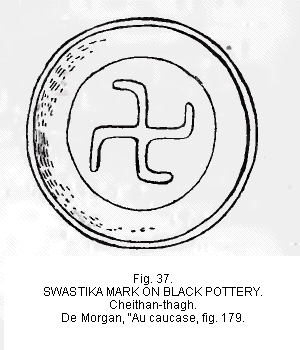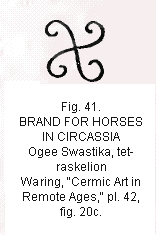

The Swastika
Dispersion of the Swastika
 Fig.
38 represents portions of a bronze plaque from that country, used
on a ceinture or belt. Another of slightly different style, but with square
cross and arms bent at right angles, is represented in his pl. 8, fig.
5. These belonged to the first age of iron, and much of the art was intricate.
(2) It represented animals as
well as all geometric forms, crosses, circles (concentric and otherwise),
spirals, meanders, chevrons, herring bone, lozenges, etc. these were sometimes
cast in the metal, at other times repoussé, and again were engraved, and
occasionally these methods were employed together. Fig.
39 shows another form, frequently employed and suggested as a possible
evolution of the Swastika, from the same locality and same plate. Fig.
40 represents signs reported by Waring (3)
as from Asia Minor, which he credits, without explanation, to Ellis’s
“Antiquities of Heraldry.”
Fig.
38 represents portions of a bronze plaque from that country, used
on a ceinture or belt. Another of slightly different style, but with square
cross and arms bent at right angles, is represented in his pl. 8, fig.
5. These belonged to the first age of iron, and much of the art was intricate.
(2) It represented animals as
well as all geometric forms, crosses, circles (concentric and otherwise),
spirals, meanders, chevrons, herring bone, lozenges, etc. these were sometimes
cast in the metal, at other times repoussé, and again were engraved, and
occasionally these methods were employed together. Fig.
39 shows another form, frequently employed and suggested as a possible
evolution of the Swastika, from the same locality and same plate. Fig.
40 represents signs reported by Waring (3)
as from Asia Minor, which he credits, without explanation, to Ellis’s
“Antiquities of Heraldry.” The
specimen shown in fig. 41 is reported by Waring, (4)
quoting Rzewusky, (5) as one
of the several branding marks used in Circassian horses for identifications.
The
specimen shown in fig. 41 is reported by Waring, (4)
quoting Rzewusky, (5) as one
of the several branding marks used in Circassian horses for identifications.Mr. Frederick Remington, the celebrated artist and literateur, has an article, “Cracker Cowboy in Florida,” (6) wherein he discourses of the forgery of brands on cattle in that country. One of his genuine brands is a circle with a small cross in the center. The forgery consists in elongating each arm of the cross and turning it with a scroll, forming an ogee Swastika (fig. 13d), which, curiously enough, is practically the same brand used on Circassian horses (fig. 41). Max Ohnefalsch-Richter (7) says that instruments of copper (audumbaroaish) are recommended in the Atharva-Veda to make the Swastika, which represents the figure S; and thus he attempts to account for the use of that mark branded on the cows in India (supra, p.772), on the horses
 in
Circassia (fig. 41), and said to have been used in Arabia.
in
Circassia (fig. 41), and said to have been used in Arabia.Many specimens of the Swastika were found by Dr. Schliemann in the ruins of Troy, principally on spindle whorls, vases, and bijoux of precious metal. Zmigrodzki (8) made from Dr. Schliemann’s great atlas the following classification of the objects found at Troy, ornamented with the Swastika and its related forms:
Fifty-five of pure form; 114 crosses with the four dots, points or alleged nail holes (Croix swasticale); 102 with three branches or arms (triskelion); 86 with five branches or arms; 63 with six branches or arms; total 420.
Zmigrodzki continues his classification by adding those which have
ENDNOTES:
1. Recherches Anthropologiques dans le Caucase,” tome deuxieme, periode protohistorique, Atlas, pl. 11, fig. 3. [Back]
2. Count Goblet d’A;viella, “La Migration des Symboles,” p. 54. [Back]
3. “Ceramic Art in Remote Ages,” pl. 41, figs. 5 and 6. [Back]
4. “Cermaic Art in Remotes Ages,” pl. 42, fig. 20c. [Back]
5. “Mines de l’Orient,” v. [Back]
6. Harper’s Magazine, August, 1895. [Back]
7. Bulletins de la Soc. d’Anthrop., 1888, ii, p. 678. [Back]
8. Dixieme Congres International d’Anthropologic et d’ Archeologic Prehistorique, Paris, 1889, p. 474. [Back]
<< Previous Page Next Page >>
© 2004-2007 Northvegr.
Most of the material on this site is in the public domain. However, many people have worked very hard to bring these texts to you so if you do use the work, we would appreciate it if you could give credit to both the Northvegr site and to the individuals who worked to bring you these texts. A small number of texts are copyrighted and cannot be used without the author's permission. Any text that is copyrighted will have a clear notation of such on the main index page for that text. Inquiries can be sent to info@northvegr.org. Northvegr™ and the Northvegr symbol are trademarks and service marks of the Northvegr Foundation.

|